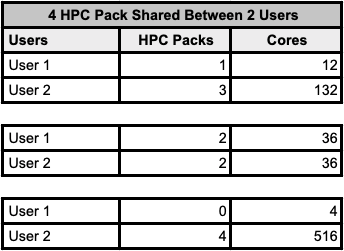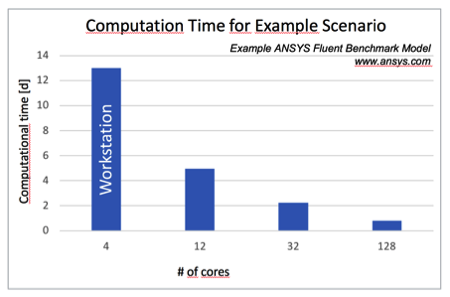Ansys Base license products (Mechanical and CFD) and HPC license products (HPC, HPC Packs, and HPC Workgroups) enable GPUs. For those who want to run high performance computing applications in the public cloud, there are limited options, but not for the reasons one might. To access ANSYS users must accept the license terms. Select the Request Access button in the ANSYS entry in the list of Officially Supported Applications on the HPC software web page to accept the license terms. Access should be enabled within a day of accepting the terms. ANSYS version 20.1 and 19.1 are installed on the HPC cluster (Henry2). . One license option enables HPC for all Electronics products: HFSS, SIwave, PSI, Q3D Extractor, Maxwell, Designer Scalable Licensing. ANSYS Electronics HPC (Singles). ANSYS Electronics HPC Packs. ANSYS Electronics HPC Workgroup (Volume access to parallel) – 128 to. Ansys Parametric Licensing Calculator. Use the form below to calculate the amount of HPC licensing needed to run concurrent parametric analyses with many Ansys solvers (such as Ansys Mechanical, Fluent, HFSS, etc.). Simply input the number of concurrent parametric analyses you wish to solve and how many cores you would like each analysis to run on.
For those who want to run high performance computing applications in the public cloud, there are limited options, but not for the reasons one might expect. Cloud providers like Amazon, for instance, have gone to great lengths to kick users the right hardware and networks for these applications and the business model for spotty HPC use has been widely discussed as a viable, more desirable alternative to the massive in-house cluster if demand is occasional.
The real problem with bringing HPC applications to the cloud has little to do with roadblocks technology-wise. Rather, it is the thorny problem of software licensing that has stalled HPC cloud adoption with few companies offering HPC software taking the first steps to find a flexible model for pricing that rolls with the on-demand, scalable nature of the cloud.
This is problematic for smaller companies who either want to pop off the workstation for more horsepower or who simply don’t specialize in HPC and need to run a quick set of demanding HPC tasks without bothering with on-site hardware. In other words, the ability for smaller companies to quickly onboard with high-end engineering packages they’re used to using in a pay-as-you go sort of cloud environment is struck down—leaving smaller companies who have hit a workstation wall but that have large-scale simulations to run with the decision to either procure and maintain a power-hungry cluster or use an HPC on demand service, which is less nimble scalability and options-wise.
With all this in mind, when the news came in today that engineering and simulation software maker, ANSYS, was going to put its code into a public cloud environment, the first thought was that this would be one of the only complex modeling and simulation environments one could spin up on Amazon Web Services nodes through the web giant’s marketplace. This would be an interesting move because for the most part, licenses for HPC simulation (and other) software have not stayed current by offering licenses that scale with the spiky demand and flow of cloud deployments. The ANSYS Enterprise Cloud, which is at the heart of the company’s announcement today, takes the idea of HPC licenses for cloud to interesting heights–but perhaps not the way one might expect.
What ANSYS has done is more of a half-step toward gearing their licenses for Amazon users. In the end, however, this might not be such a bad thing since ANSYS and Amazon as partners are handling the provisioning of the right-sized cluster and configuration for a user’s workload. In essence, as director of strategic partnerships at ANSYS, Barb Hutchings, described to The Next Platform, users are billed for both Amazon consumption and the ANSYS cloud licensing separately, but the behind the scenes complexity of setting the cluster up for the workload is handled when the user submits the job through the ANSYS cloud gateway after also setting up a virtual private cloud (VPC) account on Amazon Web Services.
At this point, the user moves out of the way and lets ANSYS manage the setup and configuration of the VPC nodes for their software, obscuring the process and doing whatever license magic they have worked on with Amazon to make the price agreeable for both users and themselves. We still have no pricing data but needless to say, licenses for ANSYS are notoriously expensive, and it is likely that either way a user chooses to go (pay a local network license of $30,000 and up for ANSYS mechanical license, for instance) or run their engineering simulations in the cloud, it is not a cost-saving measure if carried out over the long haul, particularly if one adds extended AWS usage into the cost mix.
Here is the real benefit, though. For those who are using the AWS cloud for their ANSYS jobs, there are many options available that might not be present with an on-site cluster, including the ability to tap into GPU computing nodes on AWS or to use auto-scaling to make sure the job powers up and down only when and as needed. And naturally, it lets engineering organizations extend their reach and free up cluster resources for larger or more critical workloads. But for current ANSYS users, the golden words here are “your license goes with you wherever you run.” So, in other words, and with very little detail from ANSYS in terms of how this is managed on the back-end, an existing license can be used in the cloud, from an on-demand computing partner, and of course, inside the walls of an existing datacenter.
The ANSYS enterprise cloud is not seeking out that much discussed “missing middle” of industry (those who need HPC but have a difficult time on-boarding with it). Rather, those customers are being directed to HPC as a service partners that ANSYS works with through another program. This public cloud provisioning of ANSYS software is aimed at larger-scale enterprise users who rely heavily on simulation for mission-critical engineering and design tasks.
“ANSYS Enterprise Cloud is aimed at larger-scale enterprises using simulation,” explains Hutchings. “With wide and deep sim deployments, they enterprises have users in multiple locations who need access to big resources, and they have users all around that need software licenses. There’s been a paradigm shift from sim being deployed on every desktop to consolidating those into the datacenter for better access, collaboration, and management, and cloud is the next logical extension of that consolidation trend and the enterprise cloud we’re releasing is a path to adoption if they want to move ANSYS into a cloud.”
Among those large-scale users of simulation is drive manufacturer, HGST, which is one of a handful of early testers of the service. According to Steve Phillpott, chief information officer of the disk drive maker, “HGST sees the use of cloud computing as an important paradigm shift, providing increased business agility and the capacity when and where we need it. We are impressed that the ANSYS solution delivers the full end-to-end simulation process in the cloud, allowing us to maintain models, simulate and analyze results directly in our virtual private cloud (VPC) environment. Keeping everything in HGST’s VPC mitigates compliance, connectivity, performance and latency issues that are unique challenges for complex modeling and simulation workflows such as ours.”
Ansys Hpc License Cost
Starting in 2021, ANSYS began issuing new licenses for their academic customers. Unfortunately, the names of the new licenses do not match the previous names, which means that once the new licenses are installed on the license server, users must reconfigure their ANSYS clients to use the new default license names. This is actually pretty simple to do.
Open the ANSYS Client Licensing Admin Utility
The example below uses version 17.x. You will need to adjust the selection according to the version you are running.
On the Client/Workstation:
First close all ANSYS programs, be sure to save any data you’ve been working on if necessary
For WINDOWS please select – Start /All Programs /ANSYS v17.X / ANSYS Client Licensing / Client ANSLIC_ADMIN Utility.
or click type “Client ANSLIC_ADMIN Utility 17.x” in windows search and launch the utility. Note that you should see a different version of the ANSLIC_ADMIN utility for each version of ANSYS installed on your system.
For LINUX – /ansys_inc/shared_files/licensing/lic_admin/anslic_admin
Click the button labeled Select License Preferences for User xxxxxx. Where ‘xxxxxx’ is your username. This will open the next selection screen.
Select the ANSYS Product Release
Select the release of ANSYS you wish to apply these settings to. You will normally select the ANSYS product release number you are currently running. In the example below, we’ve selected 2020 R1 since that is the version we have installed.
After you click the OK button, you will get the first screen of license preferences settings.
Set License Preferences for Each Category of Licenses
On the License Preferences screen, licenses are grouped into four categories: Solver, PrepPost, Geometry, and HPC. You will need to set similar preferences for each category. The Solver license pane is show below.
On this page, you can leave checked the box labeled “Share a single license between applications when possible”. Next, click the button Reset to Default. A confirmation page will appear:


Click the Continue button to accept the change. You should see the following:

Hpc Pack
Note that this change only applies to the Solver category of licenses. You will also need to do this for the PrepPost, Geometry, and HPC license categories.